Abstract
Complex systems composed of multiple interconnected sub-systems need to be controlled with specialized control algorithms. In this paper, two classes of control algorithms suitable for such processes are presented. Firstly, two distributed model predictive control (DMPC) strategies with different formulations are described. Afterward, a coalitional control (CC) strategy is proposed, with two different communication topologies, i.e., a default decentralized topology and a distributed topology. All algorithms were tested on the same simulation setup consisting of eight water tanks. The simulation results show that the coalitional control methodology has a similar performance to the distributed algorithms. Moreover, due to its simplified formulation, the former can be easily tested on embedded systems with limited computation storage.
1. Introduction
Distributed model predictive control (DMPC) is a preferred control strategy when dealing with complex systems. Such processes are composed of multiple sub-systems, more often completely or partially interconnected, either physically or through common shared resources or goals [1]. To control such systems, centralized control is not a reliable strategy, due to the sheer size of the computational burden, for solving a unique optimization problem [2]. Decentralized control can be applied only in the particular case of a weak interconnection between sub-systems since, from the control point of view, all of them are independently treated, deliberately ignoring the interdependent connections [3]. Thus, distributed control is a control strategy of compromise between the aforementioned ones, by independently controlling the sub-systems while also taking into account the links between them. The DMPC methodology was developed within the mature model predictive control (MPC) research field [4], in which each sub-system solves a coupled MPC optimization problem, considering both local and inter-shared information.
The subject is ongoing and in fast development, evidenced by extensive research in the DMPC field. During the last decade (i.e., publication years 2013–2023), in the Web Of Science Core Collection, around 1000 DMPC-related papers were published, with more than 500 articles published in prestigious journals such as Annual Reviews in Control, Automatica, IEEE Transactions on Control Systems Technology, Systems & Control Letters and IEEE Control Systems Magazine, among others.
The DMPC strategy was successfully applied in various domains, such as micro-grids [5,6], smart grids [7,8], traffic control [9,10,11,12,13,14], vehicle platooning [15,16,17,18] wind farms [19,20,21], wastewater treatment plants [22,23], chemical processes [24,25] or network systems [26], just to name a few. In [27], a robust DMPC algorithm for energy management optimization in a multi-microgrid system was presented. The stability of an independent microgrid with respect to the uncertainties introduced by the renewable energy sources was ensured using the advantages of robust MPC optimization. Moreover, a robust DMPC strategy was used to dynamically develop an energy schedule for the multi-microgrid system, using the advantage of power transactions between independent units. In [28], a DMPC approach for the online scheduling involved in the coordination problem between demand response and alternating current optimal power flow in a smart grid was proposed. In [29], a DMPC strategy for high-speed train traffic control was developed. To ensure smaller traveling distances between each train, a virtual coupling was considered, and proofs for feasibility and terminal invariant set constraint stability were provided. In [30], a DMPC approach for a vehicle platoon with two string stability criteria based on and norms was investigated. In [31], an economic DMPC strategy for a large-scale wind farm was introduced. For each wind turbine, a local Nash optimal solution was reached using an iterative algorithm while also ensuring the dynamic global economic target for the overall wind farm. In [22], an economic DMPC method for a wastewater treatment plant was presented. Two design approaches for the economic DMPC were proposed, with the difference consisting in the model used in the local controller. In one case, for each subsystem, the centralized plant model was used in the optimization problem, whereas the other approach used the corresponding local model defined for each subsystem in the local controller. The simulations performed in various weather conditions showed that the first approach outperforms the second one in terms of control performance. In [32], an explicit DMPC design for chemical processes was introduced. The strategy was used to handle the constraints in a matrix form, while dividing them into two sets. When compared with a classical DMPC, the simulation results obtained for a coke oven pressure control system showed the efficiency of the explicit DMPC formulation. In [33], a robust DMPC for networked control systems with uncertainties and time delays was presented. By decomposing the network optimization problem in multiple optimization sub-problems, each one described using an upper bound robust objective, the computational complexity of the algorithm was decreased.
A comprehensive recent review work on DMPC strategies classified depending on their robustness in the presence of system faults (in sensors and actuators), external cyber-attacks on the communication network or internal attacks from malignant agents inside the network that share false information is given in [34].
A highly cited review work in the DMPC field, which early on envisioned the future research trends for the next decade, is provided in [35]. Furthermore, the DMPC algorithms are classified depending on the optimization problem to be solved as:
- Non-cooperative DMPC—if each agent (or controller) solves a local cost function using both local information from its sub-system and information received from the interconnected sub-systems;
- Cooperative DMPC—if each agent solves a global cost function, taking into account both local information and information received from the entire system.Depending on the communication protocols established between different agents, the cooperative architectures are further classified as:
- -
- Iterative DMPC—if each agent exchanges information with other agents multiple times within a sampling period; to this end, the communication flow is bidirectional.
- -
- Non-iterative or sequential DMPC—if each agent exchanges information with other agents only once during a sampling period; in this case, the communication flow is unidirectional.
Moreover, based on the topology of the communication network, DMPC methods are categorized as [36]:
- Fully connected DMPC—if each agent is connected with all other agents from the network;
- Partially connected DMPC—if each agent is connected with only a group of agents within the network, called neighbours.
All the above mentioned DMPC strategies have one common denominator, namely that the communication and controller topologies are fixed, i.e., once established in the beginning, they do not change during operation. However, this characteristic is rather restrictive, and thus another methodology was introduced, called coalitional control (CC), using the principle of flexible architecture [37]. In this methodology, rather than having to choose between a fully connected or a partially connected communication network, the idea is that, during operation, in a fully connected topology, certain communication links can be disabled (if they are not necessary), thus obtaining a partially connected topology. A group of agents partially connected (through communication link activation) is called a coalition (or cooperative group), and, within the coalition, a cooperative optimization problem is solved. When the links are disabled, the coalition is dissolved, and the agents solve a non-cooperative optimization problem [38,39].
In this work, we extended the comparative performance analysis provided in [40] for two DMPC methodologies to also include a coalitional control algorithm. The contributions of this work are the following:
- A comprehensive performance analysis was performed for two non-cooperative DMPC algorithms (one formulated using a state-space model, and another formulated using an input–output model) and a CC method, described using a state-space model.
- All three algorithms were tested in simulation on the same process, i.e., the eight-tank process introduced in [40].
- The CC algorithm was based on a matrix gain feedback controller, computed by solving a gradient-based optimization problem. The basic principle of computing the gains was firstly presented in [41].
With respect to our previous works, the following novelties are listed:
- The eight-tank process model introduced in [40] was extended with the nonlinear mathematical description based on Bernoulli’s law and the mass balances.
- The DMPC strategies given in [40] are presented in an extended version.
- The gradient-based methodology for computing the gain feedback matrix in the coalitional control framework provided in [41] was reformulated to achieve comparative results with respect to the DMPC strategies. To this end, the feedback gain matrices used in the coalitional control methodology were computed solving a cost function, which minimizes the error between the coalitional state trajectories, with respect to a set of DMPC state trajectories. Moreover, a closed-loop stability constraint was also introduced.
- Two communication topologies were designed for the CC algorithm (with different sets of feedback matrices optimally computed), i.e., a default decentralized communication topology without communication between sub-systems, and a distributed topology with communication links between sub-systems.
- A procedure that automatically switches between the distributed and decentralized communication topologies designed for the coalitional control methodology is introduced.
The remainder of this paper is structured as follows: Section 2 introduces the state-space DMPC algorithm, Section 3 describes the input–output DMPC algorithm, and, in Section 4, the CC algorithm is provided. The process model description, followed by the simulation results and discussion, is given in Section 5. The conclusions and future work ideas are presented in Section 6.
2. DMPC Algorithm with State-Space Model (DMPCSS)
In this section, a non-cooperative DMPC algorithm with velocity-form formulation, designed for a system composed of N sub-systems, is presented. This algorithm was firstly introduced in [42] for a two-agent system and then extended to N sub-systems in [40].
2.1. Problem Formulation
Let us introduce a class of linear-time-invariant (LTI) systems consisting of N sub-systems, interconnected through inputs signals. Each sub-system , with the set , has the following dynamics:
with , , and the state, input, coupling inputs and output vectors for the process, respectively; k is the discrete-time index; and are matrices with adequate dimensions. All the sub-systems coupled with sub-system i are included in the set . Within this neighbourhood set, between sub-systems i and j, relevant information pertaining to the input vectors is exchanged.
Both input and output vectors are constrained as:
where and denote sets of linear inequalities.
As previously mentioned, the proposed DMPC strategy has velocity-form formulation to ensure the presence of an integral action in the control loop. This is achieved using the difference operation on both sides of (1), obtaining:
with the compact form as:
Using the same operation on (2), and substituting (5), we obtain:
The new state variable is selected as , obtaining the velocity-form model:
where I and O are the identity and zero matrix, respectively, with adequate dimensions.
In a compact form, model (7) can be written as:
where and , , , are the inputs in velocity form.
2.2. Optimization Problem
Each agent solves the following cost function :
The optimal input sequence
is computed minimizing (9), defined based on the output predictor:
where is the prediction horizon and is the control horizon. is the predicted reference trajectory, imposed constant over the prediction window, equal to the imposed setpoint at sampling time k. , is the input weight matrix.
The output predictor is interactively calculated from (8), obtaining the following compact form:
in terms of the current state (and, implicitly, the measured process state ), and the input trajectories , , and . , and are the predictor matrices.
3. DMPC Algorithm with Input–Output Model ()
In this section, a non-cooperative DMPC with an input–output model, designed for a system composed of N sub-systems, is presented. The algorithm was firstly tested on a three-agent system in [43], and extended to N sub-systems in [40].
3.1. Problem Formulation
Let us introduce an LTI system, similar to the one given in Section 2.1, where each sub-system i has the following dynamics:
with , and the input, output and disturbance vectors, respectively; is the backward shift operator; k denotes the discrete-time index; and are discrete-time transfer functions with monic denominators.
All the sub-systems coupled with sub-system i are included in the set . The disturbance term is considered as a white noise signal filtered with an appropriate model [44]. To introduce an integral action in the control loop, the disturbance model was chosen as an integrator:
where is a white noise signal.
The input and output vectors are constrained as (3).
3.2. Optimization Problem
Each agent solves the following cost function :
where is the output predictor; the input sequence is defined as the control increment over the control horizon ; is the reference trajectory imposed constant over the prediction horizon and equal with the set-point at the current time instant k; is the input weight.
The input–output MPC formulation provided in [45], which is the basis for the DMPC implementation, computes the output predictor by aggregating past and future effects:
where formulated in (16) represents the future actions, while represents the past actions and the disturbance prediction .
In compact matrix form, is calculated as:
with
where are the impulse responses from input j, , to output i, and is the corresponding step response.
Explicitly, the cost function to be minimized by each agent is:
where the incremental variable is written in matrix form . Matrix and vector are recursively computed from the formula , with being the actual input sent to the sub-system at the previous sampling instant.
Note that, in (14), the unknown variable is , , while we consider that is available inside the neighbourhood.
4. Coalitional Control with Gain Feedback Control (CC)
In this section, a coalitional control algorithm with gain feedback matrix formulation based on a state-space model is presented. The algorithm was firstly introduced in [41]. As previously mentioned, the idea behind the coalitional control is to ensure a degree of flexibility in the control architecture. This is obtained by enabling or disabling certain communication links between different agents, thus obtaining different communication topologies [41].
4.1. Problem Formulation
Consider the LTI system introduced in Section 2.1, where each sub-system i has the dynamics (1) and (2) and the constraints (3).
In the proposed CC strategy, to ensure the presence of an integral action in the control loop, an additional state was introduced. This state was defined as an integral of the control error, denoted , and defined as . This additional state was used to extend the state vector, obtaining an extended model:
where I and O are the identity and zero matrix, respectively, with adequate dimensions.
In a compact form, model (19) and (20) can be written as:
where and , , , are the input and the coupling input, respectively.
4.2. Optimization Problem
In the proposed coalitional control strategy, each agent is controlled using a state feedback gain matrix. Within the methodology, a given communication topology will have a particular form for the corresponding overall gain matrix (comprising all individual feedback matrices, correlated to each sub-system). As such, in the initialization phase of the methodology, one must decide the communication topologies that will be employed in the coalitional control. The difference between different topologies is the uni-directional communication links that are enabled, thus resulting in different overall gain feedback matrices.
Hereafter, we will formulate the following communication topologies:
- A decentralized topology, where the control action of the sub-systems is computed without external information; thus, all the communication links are disabled;
- A distributed topology, where the control action of the sub-systems is computed using relevant external information from the neighbours. This means that the communication links between neighbours are enabled.
In all tests, for each sub-system, the control action is obtained using the gain feedback matrix formulation obtained as an optimal solution that minimizes the difference between the DMPC algorithm and the feedback gain matrix solution.
Each feedback gain matrix K, corresponding to each communication topology, is computed by solving the following cost function using gradient optimization:
where is a set of state trajectories denoted , , obtained from the algorithm, simulated for M time samples.
The overall gain feedback matrix K is the optimal solution of problem (22).
Within the optimization, to compute the matrix K, a cost index is defined as the error between the state trajectory chosen as an imposed reference for the state trajectories obtained using the control law (25) corresponding to the decentralized communication topology. In this manner, we ensure that the closed-loop dynamics obtained using the coalitional control strategy are similar to the closed-loop dynamics from (i.e., we consider the response generated by the strategy to be the desired response for our coalitional control method). Moreover, note that constraint (24) ensures that all eigenvalues (computed with Matlab function eig.m) of the closed-loop system are within the unit circle, i.e., the closed-loop stability is satisfied, with the control law based on the feedback gain matrix , .
The set contains manifold state trajectories obtained by testing the process in multiple operating points feasible for the process functionality (i.e., respecting the imposed hard constraints (3)). Using this set ensures that no bias from a particular simulation case influences the computation of the optimal overall gain matrix K.
Since we wished to compare the distributed results obtained with the strategy with the coalitional ones, a distributed communication topology was defined taking into account the physical coupling between sub-systems. It resulted in an optimal feedback matrix K, which has elements , , on the main diagonal, corresponding to each sub-system and elements off-diagonal , , , corresponding to the communication links enabled between neighbours.
The overall gain matrix K for the distributed topology was computed by minimizing the same cost function (22), where (25) was rewritten as , and (24) was rewritten as , so that the interaction between neighbours is considered.
Note that, for the proposed coalitional control strategy, we designed two communication topologies. From the coalitional point of view, these two case studies can be regarded as: (i) the default test without coalitions, where the sub-systems do not exchange information, and the overall gain matrix is diagonal, and (ii) the test with uni-directional coalitions only between each two neighbours, which are coupled directly through inputs. In this case, the overall gain matrix has only one non-zero element on each row, placed off-diagonal.
As previously mentioned, the main advantage of the proposed coalitional control methodology is to minimize the communication burden of the algorithm. This is managed by opening additional communication links only when needed. In this framework, a coalitional control strategy with switching communication topologies was designed, in which the sub-systems can work either in a decentralized or in a distributed manner.
An important aspect of the coalitional control test is the criteria that switching between the two topologies are based on. In our case, we decided on a time-based framework in which, during the simulation, at each T sample times, each communication topology was re-evaluated (i.e., a cost index was computed). The evaluation was performed for the next T samples horizon, starting from the current initial conditions (i.e., similar with the receding horizon principle in DMPC). The topology that has the ‘future’ smallest cumulative cost was used for the next T sample times.
Let us denote with the cumulative cost for the distributed communication topology, computed as follows:
where denotes the number of off-diagonal, non-zero elements from gain matrix corresponding to sub-system i. The weight is selected by the user, and influences the importance given to the communication cost involved within a given topology (i.e., to provide a balance between performance and the number of enabled communication links).
In an analogous manner, the cumulative cost for the decentralized communication topology can be computed using (26) by replacing (28) with (25) and selecting , since no communication links are opened.
5. Numerical Analysis on an Eight-Tank Process
The proposed control strategies (i.e., , and CC) were tested in simulation on a process consisting of eight interconnected water tanks.
5.1. Process Description
Let us introduce a benchmark process that can be decomposed into four input-coupled sub-systems. Namely, two quadruple-tank processes, described in [46] (consisting of two sub-systems each) were connected in a circular architecture (i.e., sub-system 1 coupled with sub-system 4, which is coupled with sub-system 3, which is coupled with sub-system 2, which is coupled with sub-system 1), obtaining an eight-tank process, introduced in [40]. In Figure 1 (from [40]), the schematic diagram of the eight-tank process is provided. For this process, the idea is to control the water level in the lower tanks (, , , ) by manipulating the corresponding water flows (i.e., implicitly, by changing the voltages of the four pumps , , , ). Note that, the sub-systems are coupled through the inputs (marked in Figure 1 with dashed coloured lines). Thus, a percentage of the water flow provided by pump from sub-system 1, influences the water level from sub-system 2 (see the water flow marked with red dashed arrow).
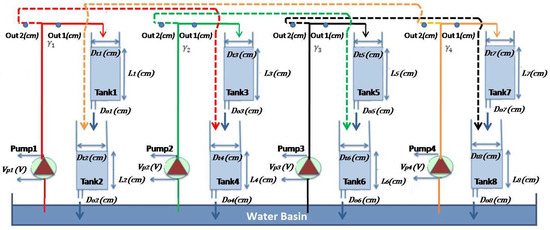
Figure 1.
Schematic diagram of the eight-tank process [40].
The nonlinear mathematical model corresponding to sub-system 1 (ensemble of two water tanks, denoted Tank 1 (upper level) and Tank 2 (lower level)) is described using the Bernoulli’s law and the mass balances, obtaining:
where is the gravitational constant on Earth, and and are the cross-section of the outflow orifice and the cross-section of Tank i, , respectively. The voltage applied to Pump i, , is and the corresponding flow is . The parameters , represent the percentages of the flow from Pump i through inlets Out 1 and Out 2, respectively, and are defined as:
where and are the upper and lower tanks inlet areas. The numerical values for the set-up parameters are derived from the user manual for the quadruple tank process provided by Quanser and are given in Table 1. Note that sub-system 1 defined with (29) and (30) is coupled with sub-system 4 through input Pump 4, since the water level depends on the flow , which is the control input in sub-system 4. The water level for the upper tank Tank 1 depends on the flow provided by Pump 1, e.g., (see Figure 1).

Table 1.
Eight-tank process from Quanser model parameters.
Following this reasoning and the schematic diagram of the process, which indicates the interconnection between sub-systems, the remaining models for sub-systems 2, 3 and 4 can be easily derived.
The nonlinear sub-system’s model was linearized in Taylor expansion in the desired equilibrium value for the lower tank level (i.e., ). Same equilibrium point values were used for sub-systems 2, 3 and 4.
The process states were chosen as deviations from the equilibrium point , , (i.e., the upper tanks equilibrium points were chosen as: , , and ). The inputs variables were defined also as deviations , , (i.e., with the equilibrium values , , and ).
Further on, after the linerization procedure, we obtained the following overall linearized state-space model for the eight-tank process:
where is the state vector, is the input vector and is the output vector. The parameters , were computed with partial derivatives.
By replacing all the numerical values provided in Table 1, we obtained the following system matrices:
The overall state-space continuous time model (32) was discretized with the sampling period s using the MATLAB function c2d.m, and the discretization method zero-order-hold, obtaining:
where , and are the discrete-time counterparts for the continuous-time system matrices from (32).
Next, the system was decomposed into four input-coupled sub-systems, hereafter denoted by , , with the following components:
where , , and are the states, input, neighbourhood set and output for , respectively. Similar definitions correspond to sub-systems , and .
With the state, input and output partitions given in (35), the discrete-time matrices of sub-systems , , are the following:
Each sub-system , , with the state-space model matrices given in (36), was converted to a minimal realization of its corresponding transfer function form using the MATLAB functions ss2tf.m and minreal.m, obtaining:
Since has a velocity-form formulation, each sub-system , , with the state-space model matrices given in (36), was converted to the augmented state-space model (8). Moreover, since the CC algorithm has an extended model with an integrator, each sub-system , , with the state-space model matrices given in (36). was converted to the extended state-space model (21).
5.2. Simulation Results
The proposed DMPC and CC strategies have the following optimization parameters and constraint limits:
- The sampling period 1 s, the prediction horizon = 30 samples and the control horizon = 30 samples;
- The input weight matrices , with , .
- The input weight , the communication cost and the horizon samples.
- The input constraints are , ;
- The output constraints are , .
All proposed methodologies were compared in a setpoint tracking test, performed on the eight-tank process described in Section 5.1. The test had a length of 1000 s and was designed as a series of step changes as follows:
- During the first 200 s, all references for all sub-systems , are equal to 5 cm.
- At time 201 s, the references values are: cm, cm, cm and cm.
- At time 401 s, the references values are: cm, cm, cm and cm.
- At time 601 s, the references values are: cm, cm, cm and cm.
- At time 801 s, the references values are: cm, cm, cm and cm.
Remark 1.
For the DMPC strategies, the numerical values for the optimization parameters were empirically chosen, after several numerical simulations, taking into account various factors such as: the open-loop dynamics of the process, the compromise between a good closed-loop performance and small control effort, etc.
The prediction horizon was selected as large enough such that the prediction will cover part of the transient response of the open-loop sub-system. However, a larger prediction horizon will result in a slower closed-loop response, with the benefit of a smaller control effort.
The input weight matrix was chosen as a compromise between a good tracking error and smaller control effort. A smaller value will put more emphasis on the minimization of the tracking error at the detriment of the value of the control effort. Taking into account that the used process is hard-constrained in the input values, it makes more sense to influence the optimization toward the minimization of the input, and the second priority is given to the tracking error.
Remark 2.
For the CC strategy with switching topologies, the values for the parameters from the cumulative cost (26) used for the evaluation of the topologies were also empirically chosen, after several tests.
Similar to the prediction horizon parameter from the DMPC, the value of the horizon T was selected as large enough to cover part of the transient response of the open-loop system. A larger value for the horizon T will influence the switching rate between topologies.
The weight γ was selected taking into account that the decentralized topology has (i.e., no links enabled). This results in a non-zero, positive value influencing the evaluation result with respect to the cumulative cost corresponding to the distributed topology. A larger value can excessively penalize the communication, forcing only the activation of the decentralized topology.
The comparative simulation results for the and strategies are given in Figure 2 and Figure 3, depicting the outputs and inputs, respectively. As expected, despite the fact that these two DMPC algorithms have different implementations, using the same optimization parameters and in identical simulation conditions, we obtained quasi-indistinguishable transient performances. This is because the distributed methodologies are similar, exchanging the optimal input between coupled sub-systems.
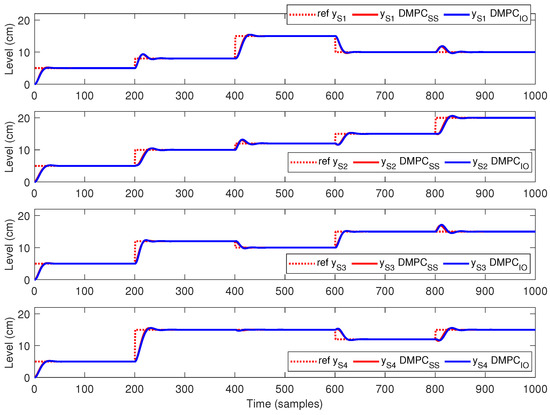
Figure 2.
Comparative simulation results for (red lines) and (blue lines) strategies—outputs for all sub-systems.
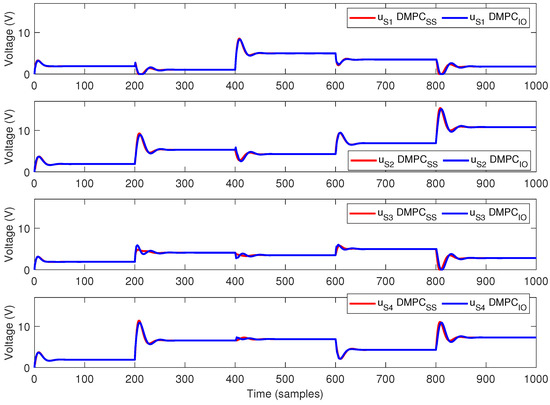
Figure 3.
Comparative simulation results for (red lines) and (blue lines) strategies—inputs for all sub-systems.
Next, the decentralized and the distributed communication topologies designed for the coalitional control strategy were comparatively tested in the same simulation scenario. The results obtained are given in Figure 4 and Figure 5, depicting the outputs and inputs, respectively. As previously mentioned, within the decentralized formulation, there are no communication links enabled between coupled sub-systems.
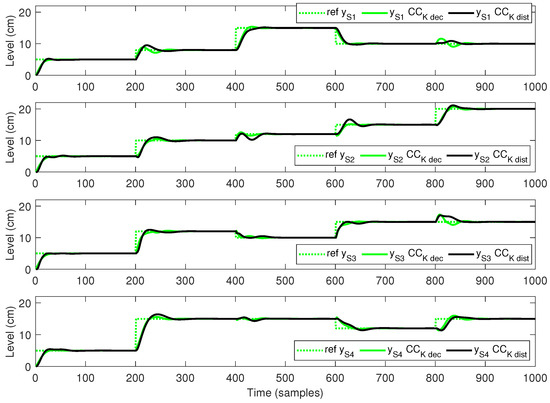
Figure 4.
Comparative simulation results for (green lines) and (black lines) strategies—outputs for all sub-systems.
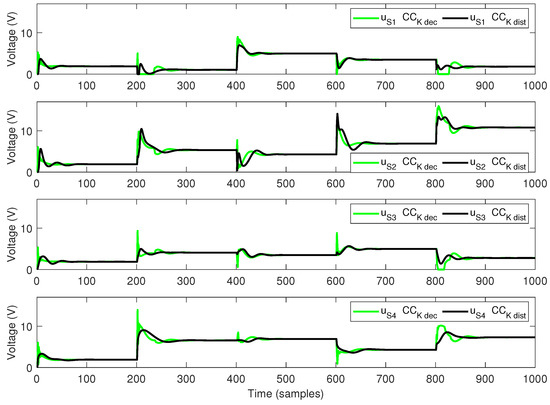
Figure 5.
Comparative simulation results for (green lines) and (black lines) strategies—inputs for all sub-systems.
For this reason, one can see that the control effort is more aggressive during the transient time when compared with the distributed topology (see Figure 5, at time 600 samples). Because, in the latter, there are communication links opened between coupled sub-systems, it results in a smoother output response.
Moreover, the strength of the proposed coalitional control methodology is the dynamical configuration of the communication topology. Thus, the next step in our analysis was to test the efficiency of the algorithm by automatically switching between the decentralized and distributed communication topologies.
The obtained results are presented in Figure 6 and Figure 7, depicting the outputs and inputs, respectively. In Figure 8, the switching times between the two topologies are presented. It is interesting to notice in this figure that the distributed topology is activated when the need for coupling information is more stringent to ensure a better response. Thus, between time 0 samples and time 390 samples, the topology is decentralized. When the simulation conditions are more challenging (see Figure 6, in the interval 390–600 samples and 790–1000 samples), the communication topology switches to distributed and shares information between sub-systems. This is partially due to the fact that sub-systems and are coupled and have opposite setpoint changes.
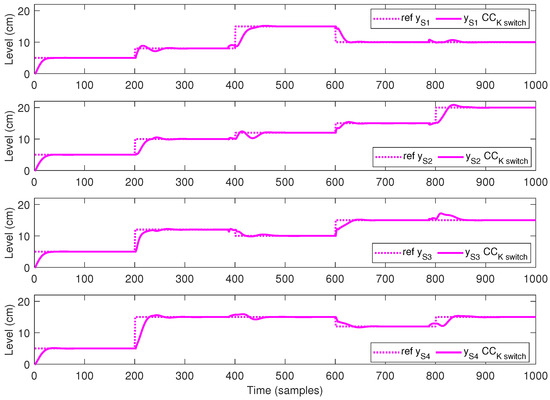
Figure 6.
Simulation results for strategy—outputs for all sub-systems.
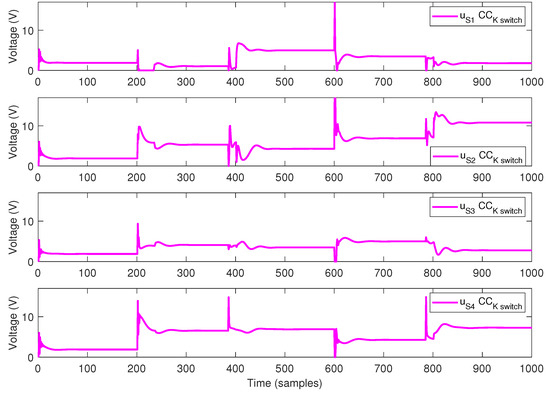
Figure 7.
Simulation results for strategy—inputs for all sub-systems.
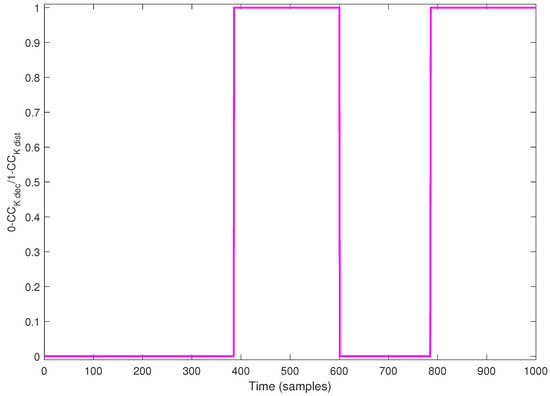
Figure 8.
Switching dynamics for strategy—1 corresponds to , whereas 0 corresponds to .
Another remark is the fact that, for this setup, if a decrease in the water level in a tank is desired, this results in a decrease in the water flow, and implicitly a lower pump voltage. However, if the coupling sub-system has a significant water level increase, due to the physical coupling between sub-systems, this can evolve to a pump saturation on the lower limit of 0 volts (see Figure 7 at time 200 samples for sub-system ).
5.3. Discussion
The performance of the proposed strategies was analyzed with respect to the following performance index:
where M is the length of the simulation time and , and are the measured output, the imposed reference and the computed input of sub-system , , at sample time k. As the numerical values given in Table 2 show, the has a slightly smaller cost index than the . When comparing the coalitional strategies using the same criteria, as expected, it results in the coalitional control with the switching communication topology outperforming the other two CC strategies, with the smallest .

Table 2.
Comparative analysis for , , , and algorithms based on performance index , overshoot () and settling time (tt).
What is noteworthy is the fact that, from this cost analysis, it results in the coalitional control methods with the gain feedback formulations having similar performances to the DMPC strategies. This outcome was expected since the CC algorithms were designed using as the results obtained with the method as a reference.
In terms of transient response performances (i.e., overshoot and settling time), for simplicity, only sub-system was analyzed, at the beginning of the experiment (first 100 samples). The results are also given in Table 2, and confirm that the DMPC strategies have comparable results with the coalitional control. The latter algorithm, based on gain feedback matrix control, provides an alternative control strategy to the optimization-based distributed model predictive control methods, and can be easily implemented on embedded systems due to its simpler formulation.
The time resource required for the local controller to compute the solution at each sampling time is: 6.75 × 10 s, 5.75 × 10 s, 6.3609 × 10 s, 6.4234 × 10 s and 6.8371 × 10 s. These numerical values show that the CC strategy is more time-efficient that the DMPC methods.
Note that the numerical value of the for given in Table 2 depends on the simulation test (i.e., the switching dynamics from Figure 8). Another simulation test, with other references, can give different results. The overall index value will be influenced by which topology is ‘dominant’ in the switching test depending on the corresponding simulation scenario.
To this end, an additional analysis was performed to evaluate the performance cost for multiple tracking scenarios. Hence, a set of 50 references was generated with the following characteristics:
- Length of the simulation time .
- The input weight .
- During the first 100 s, reference cm, at time 101 s, has a step change to a randomly generated value between 5 and 15 cm.
- During the first 200 s, reference cm, at time 201 s, has a step change to a randomly generated value between 5 and 15 cm.
- During the first 300 s, reference cm, at time 301 s, has a step change to a randomly generated value between 5 and 15 cm.
- During the first 400 s, reference cm, at time 401 s, has a step change to a randomly generated value between 5 and 15 cm.
For clarity, only the first 4 out of 50 references are depicted in Figure 9. For all 50 references, the was computed and is provided in Table 3. The results show that there are situations (see and ) in which the switching dynamics for selects only one strategy for the entire simulation. In this case, for that reference, there are two equal values for . For each algorithm, the mean of values from Table 3 is 7.32 for , 4.08 for , 6.96 for , 8.39 for and 7.02 for . These mean values reinforce the initial findings, i.e., that the coalitional control strategy has a similar performance to .
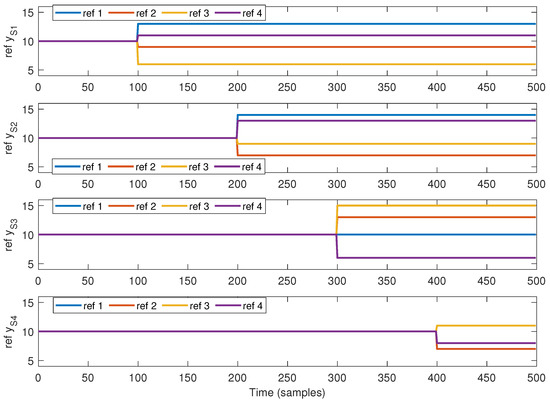
Figure 9.
First 4 out of 50 reference sets scenarios used for the performance analysis provided in Table 3.

Table 3.
Comparative analysis for , , , and algorithms based on performance index for 50 reference tracking scenarios.
Another analysis was performed to investigate the influence of the horizon T value within the switching algorithm. Using the same reference scenarios provided in Table 3, the algorithm was tested for and . For simplicity, only the mean of values are provided. Thus, algorithm has an average of 6.98 and 6.97 for and , respectively. This small difference when compared with the average cost of 7.02 corresponding to implies that there is no gain in using larger horizon values when evaluating the topologies.
With respect to satisfying the imposed hard input and output constraints, only the lower limit of the input constraint was reached and respected, whereas the upper limits were never touched.
In the coalitional control strategy, when computing the optimal K for each topology (distributed and decentralized), a closed loop stability constraint (24) was imposed within the problem. After the computation of matrix K, for each topology, the stability constraint value denoted was computed. Thus, the closed-loop stability of the coalition control strategy was assessed numerically for both communication topologies, obtaining two values within the unit circle, i.e., for and for .
Remark 3.
Both DMPC and CC algorithms were tested using an academic simulation benchmark. The simulations were performed using MATLAB R2021a on Windows 10, 64-bit Operating System with a laptop Intel Core i5-9850H CPU @ 2.60 GHz460 and 8 GB RAM. Thus, the DMPC algorithms were not yet optimized to be executed on embedded devices and to be tested in a real-time setup, but this is a subject of future work. However, the simplicity of the coalitional control formulation, as well as its reduced computation burden, makes it suitable for controlling various coupled sub-systems, using embedded devices with limited storage and computation capabilities. This endeavor is subject to ongoing work.
6. Conclusions
In this paper, a comparative performance analysis for two classes of control strategies was performed. When testing the DMPC and coalitional control strategies in a simulation setup, chosen as an eight-tank process with interconnected sub-systems, the results reveal that the coalitional methodology, based on feedback gain matrix control, is a suitable replacement for the optimization-based DMPC algorithms. Since the DMPC algorithm is based on online optimization and requires specialized optimization software, it is not trivial to use it on embedded systems, with limited capabilities. This was the motivation behind introducing the CC methodology, which has a simpler formulation based on a matrix gain feedback controller, and, once computed offline, can be easily employed on embedded systems. These findings are encouraging, and future work will test the proposed coalitional control strategy in a challenging, real-time experimental setup.
Author Contributions
Conceptualization, A.M. and C.-F.C.; methodology, A.M., O.P. and C.-F.C.; software, A.M. and O.P.; validation, A.M. and O.P.; writing—original draft preparation, A.M.; supervision, C.-F.C. All authors have read and agreed to the published version of the manuscript.
Funding
The work of A.M. and O.P. was supported by “Institutional development through increasing the innovation, development and research performance of TUIASI—COMPETE 2.0”, project funded by contract no. 27PFE /2021, financed by the Romanian government. The work of A.M. was also supported by “Gheorghe Asachi” Technical University of Iasi (TUIASI) through the Project “Performance and excellence in postdoctoral research 2022”. The work of C.F.C. was supported by a grant of the Ministry of Research, Innovation and Digitization, CNCS/CCCDI-UEFISCDI, project number PN-III-P1-1.1-TE-373 2019-1123, within PNCDI III.
Institutional Review Board Statement
Not applicable.
Informed Consent Statement
Not applicable.
Data Availability Statement
Not applicable.
Conflicts of Interest
The authors declare no conflict of interest.
Abbreviations
The following abbreviations are used in this manuscript:
| MPC | Model Predictive Control |
| DMPC | Distributed Model Predictive Control |
| DMPC with state-space model | |
| DMPC with input–output model | |
| CC | Coalitional Control |
| CC with decentralized communication topology | |
| CC with distributed communication topology | |
| CC with switching communication topology |
References
- Maestre, J.M.; Negenborn, R.R. Distributed Model Predictive Control Made Easy; Springer Science+Business Media: Dordrecht, The Netherlands, 2014. [Google Scholar]
- Espin-Sarzosa, D.; Palma-Behnke, R.; Nuñez-Mata, O. Energy Management Systems for Microgrids: Main Existing Trends in Centralized Control Architectures. Energies 2020, 13, 547. [Google Scholar] [CrossRef]
- Sun, X.; Yin, Y. Decentralized game-theoretical approaches for behaviorally-stable and efficient vehicle platooning. Transp. Res. Part B -Methodol. 2021, 153, 45–69. [Google Scholar] [CrossRef]
- Camacho, E.F.; Bordons, C. Model Predictive Control; Springer: Berlin, Germany, 1999. [Google Scholar]
- Lou, G.; Gu, W.; Xu, Y.; Cheng, M.; Liu, W. Distributed MPC-based secondary voltage control scheme for autonomous drop-control microgrids. IEEE Trans. Sustain. Energy 2017, 8, 792–804. [Google Scholar] [CrossRef]
- Cortés, A.; Martínez, S. On distributed reactive power and storage control on microgrids. Int. J. Robust Nonlinear Control 2016, 16, 3150–3169. [Google Scholar] [CrossRef]
- Liu, M.; Shi, Y.; Liu, X. Distributed MPC of aggregated heterogeneous thermostatically controlled loads in smart grids. Int. Trans. Ind. Electron. 2016, 63, 1120–1129. [Google Scholar] [CrossRef]
- del Real, A.J.; Arce, A.; Bordons, C. Combined environmental and economic dispatch of smart grids using distributed model predictive control. Electr. Power Energy Syst. 2014, 54, 65–76. [Google Scholar] [CrossRef]
- Pham, V.; Ahn, H. Distributed Stochastic MPC Traffic Signal Control for Urban Networks. IEEE Trans. Intell. Transp. Syst. 2023; early access. [Google Scholar] [CrossRef]
- Liu, P.; Ozguner, U.; Zhang, Y. Distributed MPC for cooperative highway driving and energy-economy validation via microscopic simulations. Transp. Res. Part C Emerg. Technol. 2017, 77, 80–95. [Google Scholar] [CrossRef]
- Yan, X.; Cai, B.; Ning, B.; ShangGuan, W. Online distributed cooperative model predictive control of energy-saving trajectory planning for multiple high speed train movements. Transp. Res. Part C Emerg. Technol. 2016, 69, 60–78. [Google Scholar] [CrossRef]
- Kersbergen, B.; van den Boom, T.; de Schutter, B. Distributed model predictive control for railway traffic management. Transp. Res. Part C Emerg. Technol. 2016, 68, 462–489. [Google Scholar] [CrossRef]
- Ferarra, A.; Nai Oleari, A.; Sacone, S.; Siri, S. Freeway as system of systems: A distributed model predictive control scheme. IEEE Syst. J. 2015, 9, 462–489. [Google Scholar] [CrossRef]
- Ye, B.L.; Wu, W.; Mao, W. Distributed model predictive control method for optimal coordination of signal splits in urban traffic networks. Asian J. Control 2015, 17, 775–790. [Google Scholar] [CrossRef]
- Li, H.; Zhang, T.; Zheng, S.; Sun, C. Distributed MPC for Multi-Vehicle Cooperative Control Considering the Surrounding Vehicle Personality. IEEE Trans. Intell. Transp. Syst. 2023; early access. [Google Scholar] [CrossRef]
- Pauca, O.; Maxim, A.; Caruntu, C.F. DMPC-based Data-packet Dropout Compensation in Vehicle Platooning Applications using V2V Communications. In Proceedings of the 2021 European Control Conference, Rotterdam, The Netherlands, 29 June–2 July 2021; pp. 2639–2644. [Google Scholar]
- Maxim, A.; Lazar, C.; Caruntu, C.F. Distributed Model Predictive Control Algorithm with Communication Delays for a Cooperative Adaptive Cruise Control Vehicle Platoon. In Proceedings of the 28th Mediterranean Conference on Control and Automation, Saint-Raphaël, France, 15–18 September 2020; pp. 909–914. [Google Scholar]
- Caruntu, C.F.; Braescu, C.; Maxim, A.; Rafaila, R.C.; Tiganasu, A. Distributed model predictive control for vehicle platooning: A brief survey. In Proceedings of the 20th International Conference on System Theory, Control and Computing, Sinaia, Romania, 13–15 October 2016; pp. 644–650. [Google Scholar]
- Liu, X.; Zhang, Y.; Lee, K.Y. Coordinated distributed MPC for load frequency control of power system with wind farms. IEEE Trans. Ind. Electron. 2017, 64, 5140–5150. [Google Scholar] [CrossRef]
- Spudić, V.; Conte, C.; Baotić, M.; Morari, M. Cooperative distributed model predictive control for wind farms. Optim. Control Appl. Methods 2015, 36, 333–352. [Google Scholar] [CrossRef]
- Zhao, H.; Wu, Q.; Guo, Q.; Sun, H.; Xue, Y. Distributed model predictive control of a wind farm for optimal active power control: Part II: Implementation with clustering based piece-wise affine wind turbine model. IEEE Trans. Sustain. Energy 2015, 6, 840–849. [Google Scholar] [CrossRef]
- Zhang, A.; Yin, X.; Liu, S.; Zeng, J.; Liu, J. Distributed economic model predictive control of wastewater treatment plants. Chem. Eng. Res. Des. 2019, 141, 144–155. [Google Scholar] [CrossRef]
- Foscoliano, C.; Del Vigo, S.; Mulas, M.; Tronci, S. Improving the wastewater treatment plant performance through model predictive control strategies. In Proceedings of the 26th European Symposium on Computer Aided Process Engineering, Portoroz, Slovenia, 12–15 June 2016; pp. 1863–1868. [Google Scholar]
- Albalawi, F.; Durand, H.; Christofides, P.D. Distributed Economic Model Predictive Control with Safeness-Index Based Constraints of a Nonlinear Chemical Process. In Proceedings of the 2018 Annual American Control Conference, Milwaukee, WI, USA, 27–29 June 2018; pp. 2078–2083. [Google Scholar]
- Zhang, S.; Zhao, D.; Spurgeon, S.K.; Yan, X. Distributed Model Predictive Control for the Atmospheric and Vacuum Distillation Towers in a Petroleum Refining Process. In Proceedings of the 11th UKACC International Conference on Control, Belfast, North Ireland, 31 August–2 September 2016. [Google Scholar]
- Ocampo-Martinez, C.; Puig, V.; Cembrano, G.; Quevedo, J. Application of predictive control strategies to the management of complex networks in the urban water cycle. IEEE Control Syst. 2013, 33, 15–41. [Google Scholar]
- Zhao, Z.; Guo, J.; Luo, X.; Lai, C.S.; Yang, P.; Lai, L.; Li, P.; Guerrero, J.; Shahidehpour, M. Distributed Robust Model Predictive Control-Based Energy Management Strategy for Islanded Multi-Microgrids Considering Uncertainty. IEEE Trans. Smart Grid 2022, 13, 2107–2120. [Google Scholar] [CrossRef]
- Shi, Y.; Tuan, H.D.; Savkin, A.V.; Lin, C.T.; Zhu, J.G.; Poor, H.V. Distributed model predictive control for joint coordination of demand response and optimal power flow with renewables in smart grid. Appl. Energy 2021, 209, 116701. [Google Scholar] [CrossRef]
- Liu, Y.; Liu, R.; Wei, C.; Xun, J.; Tang, T. Distributed Model Predictive Control Strategy for Constrained High-Speed Virtually Coupled Train Set. IEEE Trans. Veh. Technol. 2022, 71, 171–183. [Google Scholar] [CrossRef]
- Zhou, Y.; Wang, M.; Ahn, S. Distributed model predictive control approach for cooperative car-following with guaranteed local and string stability. Transp. Res. Part B 2019, 128, 69–86. [Google Scholar] [CrossRef]
- Kong, X.; Ma, L.; Wang, C.; Guo, S.; Abdelbaky, M.A.; Liu, X.; Lee, K.Y. Large-scale wind farm control using distributed economic model predictive scheme. Renew. Energy 2022, 181, 581–591. [Google Scholar] [CrossRef]
- Teng, Y.; Bai, J.; Wu, F.; Zou, H. Explicit distributed model predictive control design for chemical processes under constraints and uncertainty. Can. J. Chem. Eng. 2023; early access. [Google Scholar] [CrossRef]
- Zhang, L.; Wang, J.; Liu, Z.; Li, K. Distributed MPC for tracking based on reference trajectories. In Proceedings of the 33rd Chinese Control Conference, Nanjing, China, 28–30 July 2014; pp. 7778–7783. [Google Scholar]
- Arauz, T.; Chanfreut, P.; Maestre, J.M. Cyber-security in networked and distributed model predictive control. Annu. Rev. Control 2022, 53, 338–355. [Google Scholar] [CrossRef]
- Christofides, P.D.; Scattolini, R.; Muñoz de la Peña, D.; Liu, J. Distributed model predictive control: A tutorial review and future research directions. Comput. Chem. Eng. 2013, 51, 21–41. [Google Scholar] [CrossRef]
- Scattolini, R. Architectures for distributed and hierarchical Model Predictive Control—A review. J. Process Control 2009, 19, 723–731. [Google Scholar] [CrossRef]
- Fele, F.; Maestre, J.M.; Camacho, E.F. Coalitional control: Cooperative game theory and control. IEEE Control Syst. 2017, 37, 53–69. [Google Scholar]
- Chanfreut, P.; Maestre, J.M.; Camacho, E.F. A survey on clustering methods for distributed and networked control systems. Annu. Rev. Control 2021, 52, 75–90. [Google Scholar] [CrossRef]
- Maxim, A.; Caruntu, C.F. A Coalitional Distributed Model Predictive Control Perspective for a Cyber-Physical Multi-Agent Application. Sensors 2021, 21, 4041. [Google Scholar] [CrossRef]
- Maxim, A.; Caruntu, C.F.; Lazar, C.; De Keyser, R.; Ionescu, C.M. Comparative Analysis of Distributed Model Predictive Control Strategies. In Proceedings of the 23rd International Conference on System Theory, Control and Computing, Sinaia, Romania, 9–11 October 2019; pp. 468–473. [Google Scholar]
- Maxim, A.; Pauca, O.; Maestre, J.M.; Caruntu, C.F. Assessment of computation methods for coalitional feedback controllers. In Proceedings of the 2022 European Control Conference, London, UK, 12–15 July 2022; pp. 1448–1453. [Google Scholar]
- Maxim, A.; Ionescu, C.M.; Caruntu, C.F.; Lazar, C.; De Keyser, R. Reference Tracking using a Non-Cooperative Distributed Model Predictive Control Algorithm. In Proceedings of the 11th IFAC Symposium on Dynamics and Control of Process Systems, including Biosystems, Trondheim, Norway, 6–8 June 2016; pp. 1079–1084. [Google Scholar]
- Maxim, A.; Copot, D.; De Keyser, R.; Ionescu, C.M. An industrially relevant formulation of a distributed model predictive control algorithm based on minimal process information. J. Process Control 2018, 68, 240–253. [Google Scholar] [CrossRef]
- De Keyser, R.; Ionescu, C.M. The disturbance model in model based predictive control. In Proceedings of the 2003 IEEE Conference on Control Applications, Istanbul, Turkey, 25–25 June 2003; pp. 446–451. [Google Scholar]
- De Keyser, R. Model Based Predictive Control for Linear Systems. In UNESCO Encyclopaedia of Life Support Systems, Control Systems, Robotics and Automation—Vol. XI, Article Contribution 6.43.16.1; Eolss Publishers Co. Ltd.: Oxford, UK, 2003; Available online: http://www.eolss.net/sample-chapters/c18/e6-43-16-01.pdf (accessed on 1 January 2023).
- Maxim, A.; Ionescu, C.M.; Copot, C.; De Keyser, R.; Lazar, C. Multivariable model-based control strategies for level control in a quadruple tank process. In Proceedings of the 17th International Conference on System Theory, Sinaia, Romania, 11–13 October 2013; pp. 343–348. [Google Scholar]
Disclaimer/Publisher’s Note: The statements, opinions and data contained in all publications are solely those of the individual author(s) and contributor(s) and not of MDPI and/or the editor(s). MDPI and/or the editor(s) disclaim responsibility for any injury to people or property resulting from any ideas, methods, instructions or products referred to in the content. |
© 2023 by the authors. Licensee MDPI, Basel, Switzerland. This article is an open access article distributed under the terms and conditions of the Creative Commons Attribution (CC BY) license (https://creativecommons.org/licenses/by/4.0/).